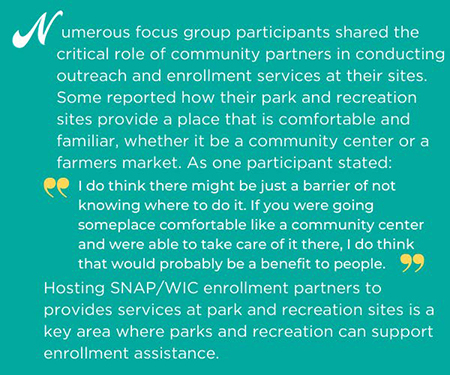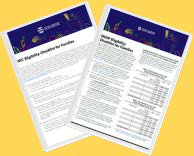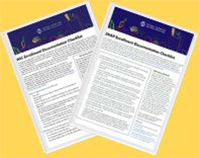At NRPA, we believe parks and recreation are vital to community health and well-being. Access to these spaces, programs and services remains essential to community vitality and is a key factor in advancing health equity, improving individual and community-level health outcomes and enhancing quality of life. Park and recreation professionals and their agencies protect and promote health for all people in the communities where people live, learn, work and play. Learn more from NRPA about the role parks and recreation plays in providing healthy meals and nutrition education on our webpage — Community Wellness Hubs Provide Food Services.
NRPA developed this toolkit to provide the information and resources park and recreation professionals need to make the case for integrating food assistance programs into their spaces. Explore this online toolkit to find the information and resources you need to make the case for integrating the following food assistance programs into your park and recreation space:
- Supplemental Nutrition Assistance Program (SNAP)
- Special Supplemental Nutrition Program for Women, Infants, and Children (WIC)
This toolkit compiles guidance, support and promising practices for park and recreation professionals to provide SNAP/WIC outreach directly to community members, connecting them to enrollment and retention assistance for increased access to affordable and healthy foods. In January 2022, NRPA conducted virtual focus groups with park and recreation professionals to learn how the field is currently engaging with SNAP and WIC programs, what common challenges the field faces, and how resources can support the field with navigating federal meal programs.
Most park and recreation professionals reported operating farmers markets where SNAP EBT and WIC are commonly accepted forms of payment. Focus group participants also shared they are more likely and more comfortable operating as SNAP/WIC referrers than to perform direct outreach and enrollment services. Professionals also agreed that bringing partners into their sites to conduct enrollment has been an effective method for increasing SNAP/WIC enrollment.
In addition to successes, park and recreation professionals shared common obstacles and challenges to increasing SNAP/WIC enrollment and outreach. Three key themes summarized the challenges expressed by focus group participants:
- Lack of knowledge and confidence about the SNAP/WIC enrollment process and eligibility thresholds keeps many park and recreation staff from more involvement in supporting SNAP/WIC outreach and enrollment activities.
- Lack of staff is the major capacity issue. Park and recreation professionals wear many hats and have competing priorities, so adding new responsibilities to their portfolios may not be realistic or achievable.
- Individual and vendor SNAP applications are confusing and difficult to complete, resulting in many people not submitting their benefits registration
- For farmers markets, the administrative challenge and burden results in many vendors and markets not fully implementing SNAP/WIC as an accepted payment method.
This toolkit has been developed to support park and recreation agencies in developing new approaches and strategies to overcome these challenges and increase community access to nutrition assistance programs. Many of the practices have been implemented with success in local park and recreation agencies. In 2020 to 2022, NRPA’s Parks as Community Wellness Hub grantees piloted a variety of new food access strategies to support Community Wellness Hubs, with an emphasis on expanding SNAP and WIC outreach and enrollment support. Strategies included:
Strategies to Improve Access to SNAP and WIC Through Community Wellness Hubs
-

Connecting community members to informational resources (fliers with eligibility information, etc.) and partners to support enrollment in SNAP and WIC.
- Partnering with local coalitions and SNAP enrollment providers to train park and recreation staff in benefit enrollment support and conducting food security screening and referrals.
- Developing an online questionnaire and referral system for community members to be immediately connected with information for how to apply online to eligible assistance programs.
- Hiring community health workers or AmeriCorps Vistas trained in SNAP/WIC enrollment.
- Inviting local SNAP and WIC offices to park and recreation events and site
Promising Practices for SNAP and WIC Outreach
|
Use the following steps — categorized by the amount of effort needed — to bring meal assistance programs to your community.
|
| Low Intensity |
Medium Intensity |
High Intensity |
| Place promotional materials (fliers, postcards, etc.) that provide information on SNAP/WIC nutrition assistance, community partner services and other benefit programs at park and recreation sites. |
Anonymously survey community members and park and recreation patrons to learn about the food security needs and opportunities for assistance that are relevant to your community. |
Hire a community health worker or Americorps volunteer, who is trained in SNAP/WIC/federal benefits navigation, to conduct food insecurity screenings and referrals.
|
| Invite someone from your local SNAP/WIC/health office to provide information about SNAP/WIC to community members and staff. |
Train all staff in conducting food insecurity screenings to confidently connect families to nutrition assistance programs. |
Designate park and recreation sites as community supported agriculture (CSA) pick-up locations where community members can use double-matching SNAP dollars to purchase locally grown produce. |
| Invite someone from your local SNAP/WIC/health office to conduct benefits enrollment assistance at park and recreation sites. |
Create an online referral system for connecting community members to appropriate programs and services after they complete an online food security questionnaire. |
Host farmers markets that accept SNAP, WIC and senior food vouchers at park and recreation sites. |
| Track outputs for SNAP/WIC outreach such as the number of materials distributed, outreach events hosted, SNAP/WIC trainings conducted, community members referred, etc. |
Partner with other organizations to create multilingual fliers (reflecting the languages spoken in your community) to promote SNAP and WIC throughout your community. Compensate partners for their role. |
Share enrollment challenges with state SNAP/WIC offices and discuss opportunities for improving the enrollment system to benefit community members. |
| Review local public health and school district data to determine neighborhoods with the highest rates of food insecurity, where outreach and relationship building can be targeted. |
Add optional demographic questions to data collection tools (registration forms, enrollment forms, etc.) to identify people who may be interested in learning more about benefit programs. |
Partner with a SNAP/WIC outreach and enrollment provider to train staff on federal nutrition programs. |
| Invest time and resources building relationships with community-based organizations and community members to better understand challenges related to SNAP/WIC and food access. |
Join an anti-hunger coalition or bring community partners together to inventory local resources, challenges and explore upstream solutions. |
Offer park and recreation facility space for community partners to facilitate SNAP Ed and SNAP E&T programs. |
Use the U.S. Department of Agriculture’s Contact Map to find contacts for SNAP, WIC, and other nutrition assistance programs in your state. For more examples of how your agency can partner with SNAP and WIC offices to conduct outreach and enrollment assistance, view the WIC/SNAP Office Partnerships resource.
Resources
The following resources can assist with expanding the use of SNAP and WIC at farmers market and grocery stores, provide SNAP and WIC eligibility checklist forms that explain the enrollment process and eligibility thresholds for staff to share with community members, offer plug and play templates for communication and support in federal meal programs, provide strategies for building partnerships with SNAP and WIC offices to decrease capacity pressures and support enrollment assistance, and offer a library of resources for additional support. All materials in this toolkit have been developed to support parks and recreation in addressing the challenges described and in serving their communities as Community Wellness Hubs.
SNAP/WIC Office Partnerships is comprehensive resource that guides park and recreation agencies through strategies for partnering with their local SNAP and WIC health offices. This resource includes a variety of strategies for conducting outreach and enrollment assistance with SNAP/WIC offices, including examples and experiences from local park and recreation agencies.
The Food Insecurity Screening Questionnaire and Suggestions supports park and recreation agencies with how to identify individuals that are at risk of food insecurity, and connect qualifying community members with SNAP/WIC benefits and/or additional nutrition supports in the community. NRPA recommends having program staff trained in how to use this guide to sensitively screen adults in confidence. Another strategy is having a designated staff member who can be trained in screening families for food insecurity and referring them to eligible nutrition assistance programs. In one year, 15 grantees from the 2020 Parks as Community Wellness Hubs grant conducted over 13,000 food insecurity screenings. Some park and recreation agencies have linked this questionnaire to their website in an online format. Depending on how users complete the online questionnaire, they are shown resources for federal meal programs in their state and locality. Regardless of the method utilized, this questionnaire is designed to be adapted by park and recreation sites to increase food security in their communities.
Customizable SNAP and WIC Eligibility Checklists
Customizable SNAP and WIC Eligibility Checklists enable park and recreation community members to quickly assess their likelihood of SNAP or WIC benefit qualification in consultation with park and recreation or other service providers. These resources provide information on ways to access and use SNAP/WIC benefits, and define common terms used in the enrollment application. Both checklists can be customized with agency information for sharing with their community members.

Customizable SNAP and WIC Enrollment Assistance Checklists
Customizable SNAP and WIC Enrollment Assistance Checklists are available for park and recreation community members to review and collect necessary documents to bring to SNAP enrollment appointments. These checklists are one page long and list all necessary items needed to apply for SNAP or WIC benefits. Both checklists can be customized with agency information to be used in their community.

Using SNAP/WIC Benefits at the Grocery Store is a comprehensive resource with guidance and easy to use tools for meal planning, tips for shopping on a budget, WIC-specific shopping suggestions, tasty recipes, and printable worksheets for meal prep and planning.
Using SNAP/WIC Benefits at the Farmers Market is a two-page resource for park and recreation community members that highlights the benefits of using SNAP/WIC benefits at farmers markets and provides information for how to find a local farmers market that accepts SNAP/WIC benefits. The resource also shares food safety tips for how to maintain freshness in food purchased from farmers markets, and a recipe that can be quickly prepared with any fresh herbs or vegetables purchased from your local market.
NRPA's nutrition literacy curriculum, Foods of the Month, is specifically designed for park and recreation agencies to implement at their sites. All materials are free, downloadable, and easy to implement. These simple lessons, fun activities, and promotional materials encourage healthy behaviors in youth and families to eat a wide range of nutritious foods. Foods of the Month provides a fun and educational complement to food access programming and services in parks and recreation.
Suggested talking points and effective outreach strategies, messaging guidance, case studies and supportive opportunities to expand access to SNAP/WIC in communities.


